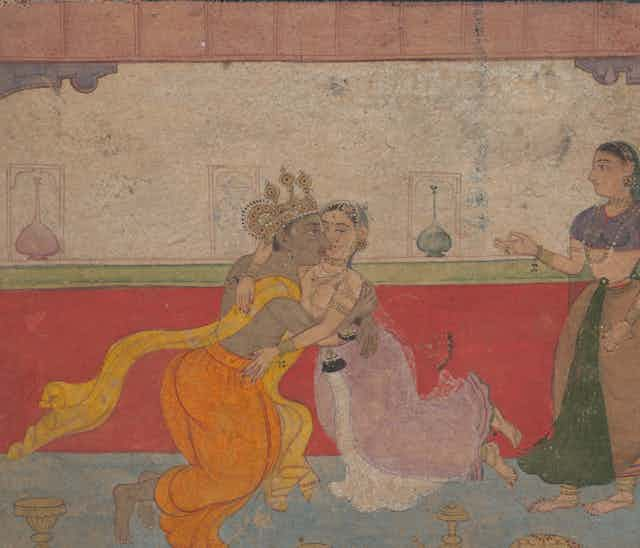Although it originated as a Christian holiday in honor of St. Valentine, Valentine’s Day has become a global celebration of romantic love, observed by people of many religions and of no religion.
Other religions have long had their own myths centered on love. I have observed, in my work as a scholar of Hinduism, Jainism and Buddhism, that in Hindu traditions, there are many stories of divine couples: deities who embody the ideal of love, and whose stories often contain lessons for the rest of us. One couple that has especially captured the imagination of Hindu devotees for centuries is Radha and Krishna.
Who is Krishna?
The story of Radha and Krishna is first found in the Bhagavata Purana, a text dated by scholars as somewhere between the fifth and 10th centuries. Their story is further elaborated in the Sanskrit devotional poem “Gitagovinda,” authored by Jayadeva, who lived in the 12th century in Eastern India.
Krishna, a highly popular and beloved Hindu deity, is regarded, depending on which textual tradition you read, either as an avatar or incarnation of the deity Vishnu, or as the Supreme Being himself. In Hindu belief, Vishnu preserves the order of the cosmos, often through taking on an earthly form to right some wrong and to set the world back on the correct course when chaos threatens to overwhelm it.
The life story of Krishna is an exciting one, full of adventure as well as tragedy. When Krishna is born, his evil uncle, a king named Kamsa, orders all of the male children of the kingdom who are born on that night killed, not unlike King Herod in the New Testament. This was due to a prophecy that one of those children would put an end to his reign. Krishna’s parents, however, are warned of this impending calamity, and the baby is spirited away to safety.
Krishna, therefore, who is born to royalty, has a humble upbringing, growing up amid the cowherds and cowherdesses, or gopis, of the bucolic region of Vrindavan. Stories of Krishna’s teenage years, in particular, are greatly beloved by his devotees. This was a relatively carefree time in Krishna’s life, when he engaged in all kinds of playful mischief with the gopis, and wandered the forests of Vrindavan playing his flute. All of the gopis fell in love with Krishna, and he with them, but the one with whom he fell in love the most deeply was named Radha.
The story of the love of Radha and Krishna is overshadowed by an air of tragedy. The two cannot be together, as Radha is already married and Krishna has a great destiny ahead of him. When the time comes, Krishna must leave Vrindavan and overthrow his wicked uncle, and also play a key role in the fight between two groups of warring brothers, the Pandavas and the Kauravas.
Divine love
This tragic story is dear to devotees not only because of the very real human feelings it evokes, but also because of its deep theological significance in the Vaishnava tradition – the Hindu tradition in which this story features most prominently.

To some, the love between Radha and Krishna might appear to be adulterous or scandalous, given that she is married. The focus of the tradition, though, is not so much on this scandal, but on the deep, spontaneous, genuine love that it illustrates. Radha’s love for Krishna is so strong that it is willing to fly in the face of social conventions. She is willing to risk the disapproval of her community for this love. And according to Vaishnava theology, this is how individuals’ love for God should be. True love for God – called bhakti, or devotion – should be characterized by wild abandon. It should be spontaneous and free.
In Vaishnava theology, the gopis represent the many jivas, or souls, that dwell in the universe, while Krishna is Ishvara, the Lord, the Supreme Being. A very popular and beautiful artistic depiction of the relationship between Krishna and the gopis is called the “Ras Lila.” It depicts the gopis dancing in a circle. Each of them has Krishna for a partner. He has used his divine power to multiply himself so he can dance with each gopi individually.
When Krishna finally has to leave Vrindavan, the pain of separation Radha feels is almost unbearable. When she asks Krishna why she has to feel such pain, he tells her that she must learn to see him in all beings, for he dwells in the hearts of all. The individual soul’s sense of separation from God is similarly painful, and is believed to be a particularly powerful manifestation of bhakti. But that separation can be overcome by seeing God in all beings and in one another.
As Krishna also says in the Bhagavad Gita, “I am never lost to one who sees all beings in me and who sees me in all beings, nor is that person ever lost to me.”
The story of Radha and Krishna can therefore be enjoyed on Valentine’s Day on two levels: as a sad and poignant tale of a past youthful love, remembered fondly but left behind by the call of adulthood, but also as an invitation to be open to love in all its forms.

